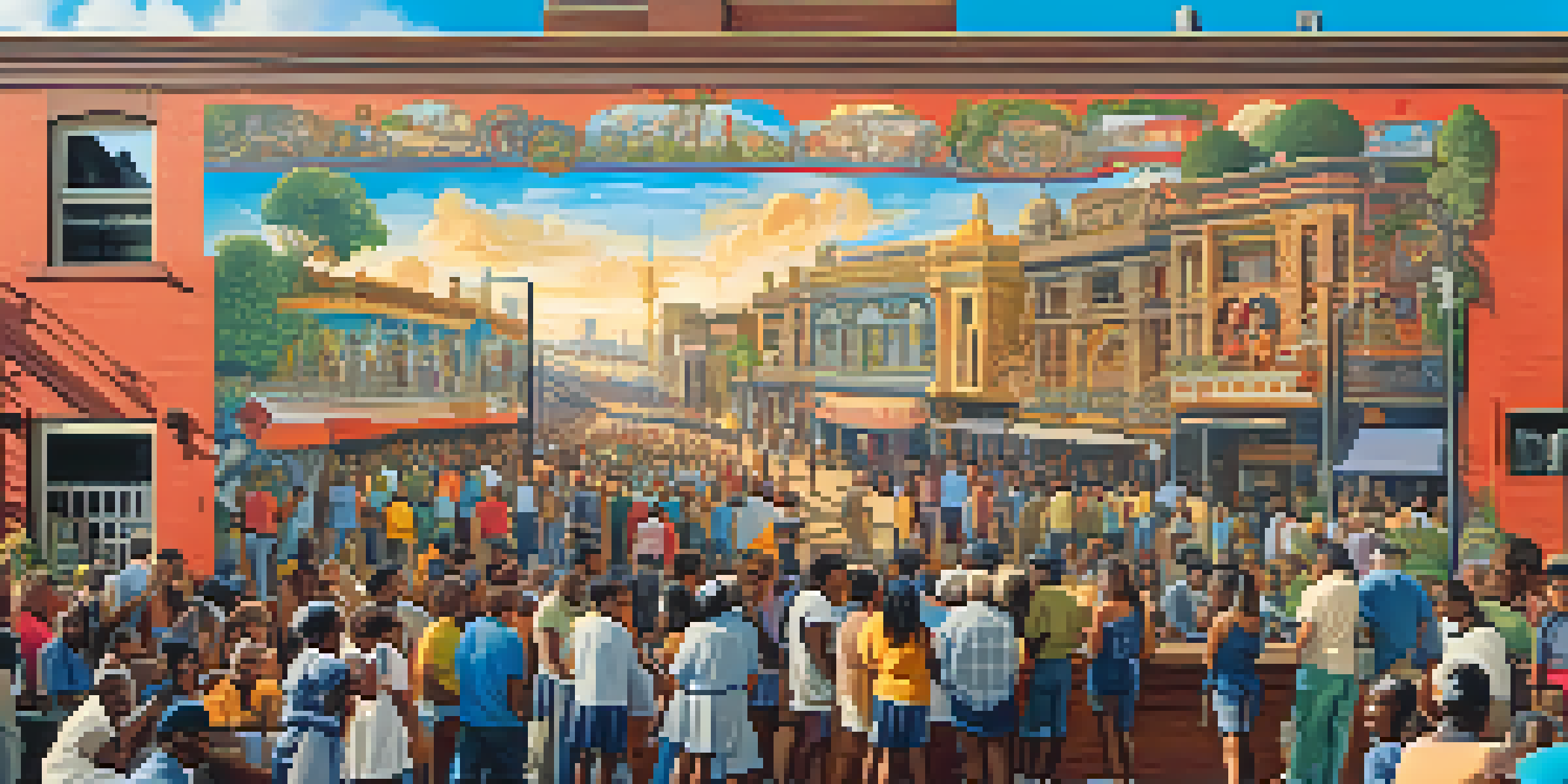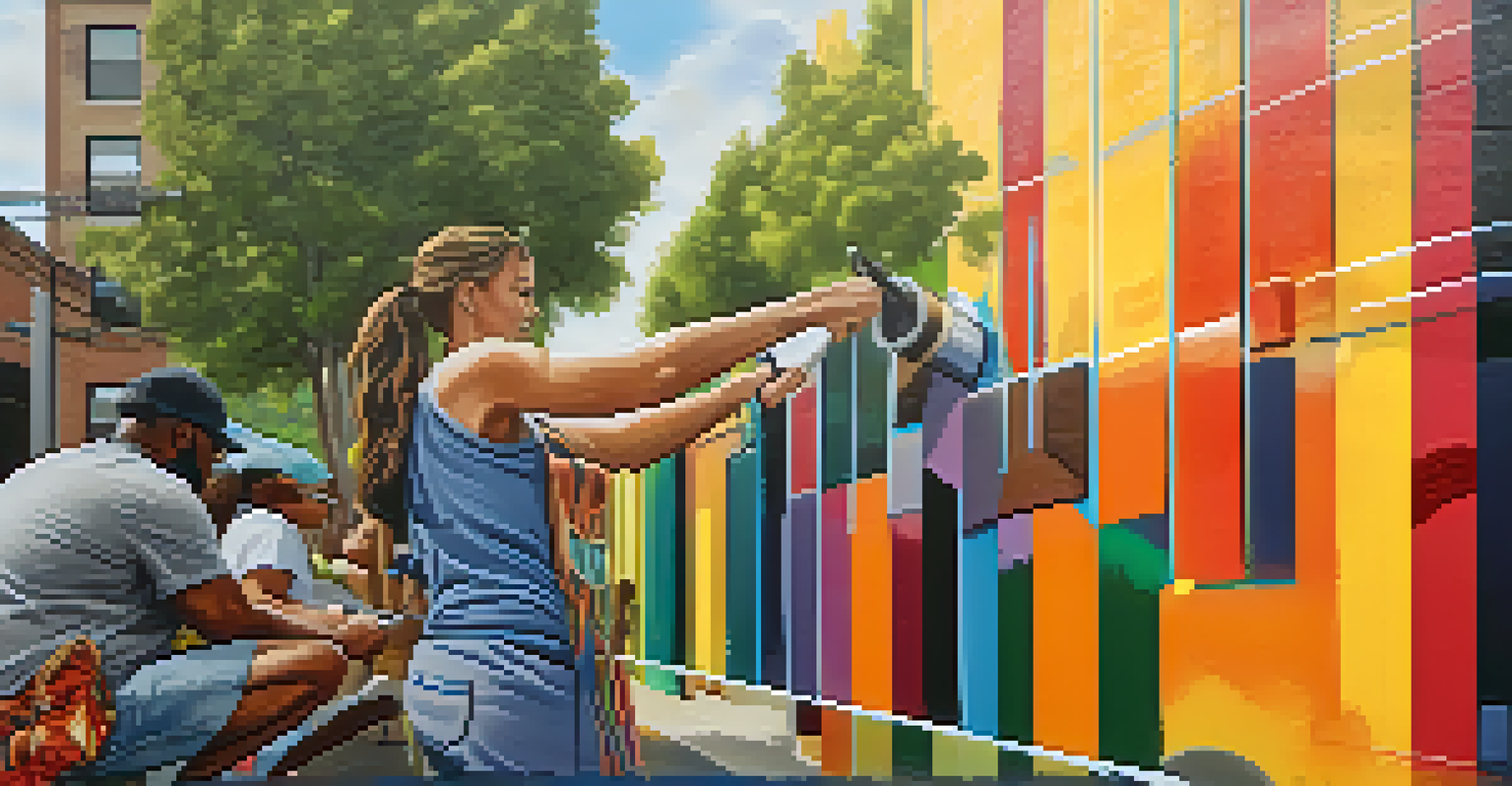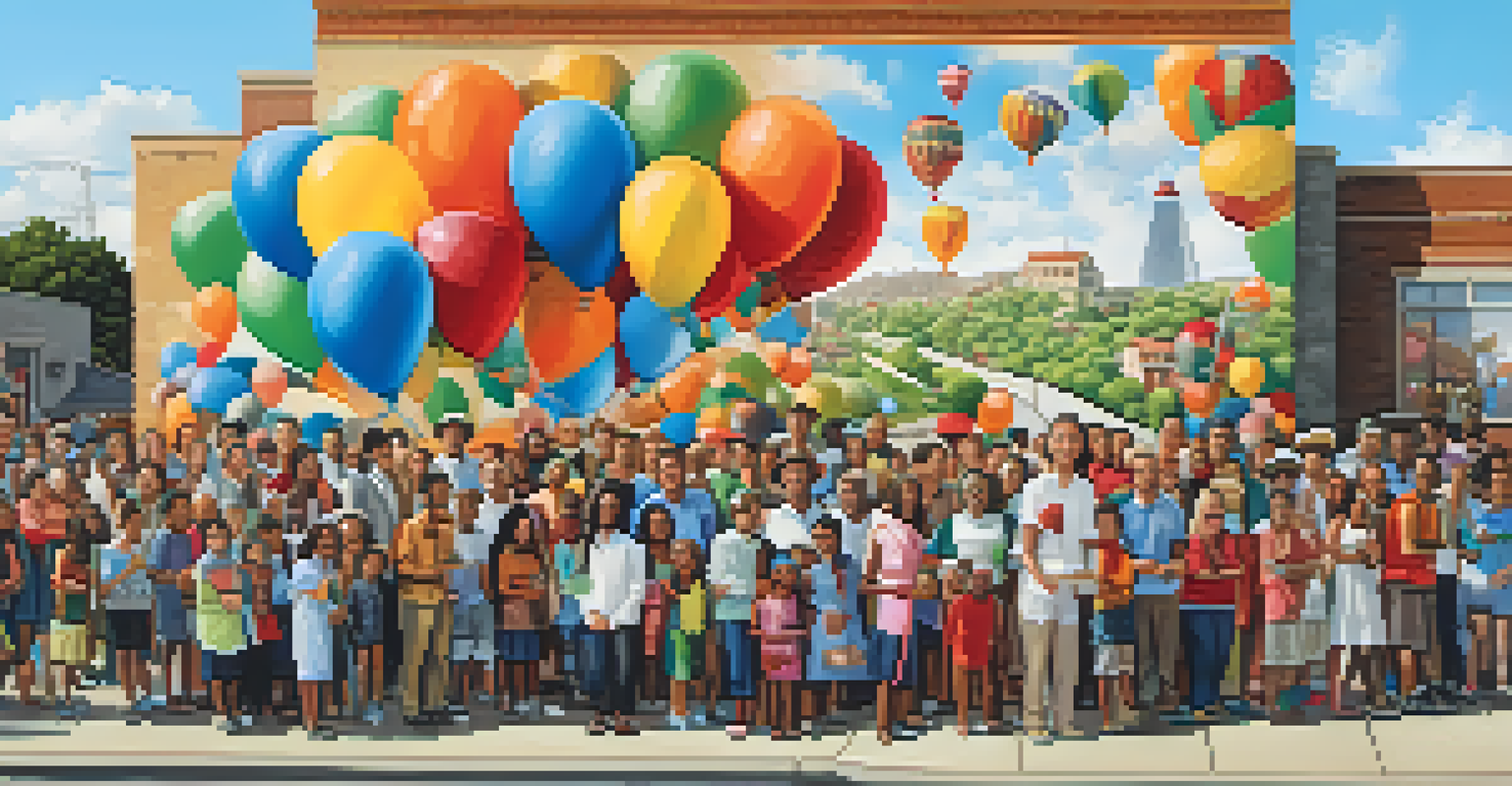Public Murals: Enhancing City Life and Local Identity

The Role of Public Murals in Urban Environments
Public murals serve as vibrant canvases that transform cityscapes, injecting color and life into often dull urban areas. They provide a unique way to showcase local culture and history, making the surroundings more inviting. By creating a visual dialogue, murals can engage residents and visitors alike, drawing them into a deeper appreciation of the community.
Art is the most beautiful of all lies.
These works of art often reflect the stories, struggles, and achievements of local residents. For instance, a mural depicting a historical event can spark conversations and connections among those who have lived through it or are learning about it for the first time. This shared experience fosters a sense of belonging and pride in the community.
Moreover, murals can also serve practical purposes, such as reducing graffiti and vandalism in neglected areas. By replacing unsightly tags with beautiful artwork, cities can reclaim public spaces and encourage positive interactions among residents. This transformation not only beautifies the environment but also enhances safety and encourages community engagement.
Fostering Local Identity Through Art
Public murals play a significant role in expressing and shaping local identity. They often incorporate elements that resonate with the community, such as symbols, colors, and themes that reflect cultural heritage. This connection to local identity helps residents feel more connected to their surroundings and contributes to a richer community narrative.

For example, a mural that features local landmarks or notable figures can evoke a sense of nostalgia and pride among residents. It serves as a visual reminder of what makes their neighborhood unique, fostering a shared identity that can bridge generational gaps. Such art invites everyone to celebrate their roots and appreciate the richness of their local culture.
Murals Enhance Urban Identity
Public murals reflect local culture and history, fostering a sense of belonging and pride among residents.
In many cases, community members are involved in the creation process, nurturing a sense of ownership over the artwork. Collaborative projects that invite local artists and residents to participate can lead to murals that truly reflect the community's spirit. This involvement not only solidifies local identity but also strengthens community bonds through shared creativity.
Economic Impact of Public Murals
Beyond aesthetics, public murals can significantly boost local economies. They attract tourists, art enthusiasts, and photographers, eager to capture and share the visual storytelling found in these large-scale artworks. This influx of visitors can lead to increased foot traffic for local businesses, creating a ripple effect that benefits the entire community.
Public art is an essential part of a community's identity and its future.
Additionally, murals can enhance property values in their vicinity, as neighborhoods known for their vibrant street art often become more desirable places to live and work. Real estate agents frequently highlight proximity to these artistic displays as a selling point, making homes more appealing to potential buyers. This can lead to a cycle of investment and revitalization in previously overlooked areas.
Cities that embrace public murals often invest in the arts and culture sector, further promoting economic growth. By funding mural projects and supporting local artists, municipalities can create jobs and stimulate artistic innovation. This, in turn, fosters a vibrant cultural scene that attracts even more visitors and residents, creating a thriving urban environment.
Community Engagement and Participation
Public murals often serve as a platform for community engagement, inviting local residents to participate in the artistic process. Workshops and planning sessions allow community members to voice their ideas and collaborate with artists, fostering a sense of ownership and pride. This participatory approach transforms murals into collective expressions of the community's values and aspirations.
When residents are actively involved in the creation of murals, they develop a deeper connection to the artwork and their neighborhood. This collaboration can also empower marginalized voices, giving them a space to share their stories and experiences. As a result, murals become more than just art; they evolve into powerful statements that reflect the diversity and richness of the community.
Economic Boost from Street Art
Murals attract tourists and enhance property values, benefiting local businesses and stimulating economic growth.
The act of painting a mural can also serve as a bonding experience for those involved. Neighbors working side by side on a project can develop friendships and strengthen ties, creating a more cohesive community. As people come together to celebrate their shared vision, they foster a supportive environment that encourages further collaboration and unity.
Murals as Tools for Social Change
Public murals have the unique ability to address social issues and inspire change. Many artists use their work to highlight pressing topics such as racial inequality, environmental concerns, and mental health awareness. By presenting these issues visually, murals can provoke thought and encourage conversations that might otherwise be uncomfortable or overlooked.
For instance, a mural depicting the struggles faced by a marginalized community can raise awareness and foster dialogue among residents. This art becomes a catalyst for change, inviting the public to reflect on their values and behaviors. Such murals can lead to activism, encouraging community members to take action toward addressing the issues represented.
Furthermore, murals can celebrate resilience and hope, offering uplifting messages that inspire positivity in the face of adversity. By showcasing stories of triumph over hardship, artists can instill a sense of empowerment among viewers. These powerful visuals remind communities of their strength and solidarity, reinforcing a collective commitment to creating a better future.
The Process of Creating Public Murals
Creating a public mural is a collaborative and often intricate process that requires planning, skill, and community input. It typically begins with brainstorming sessions where artists, community members, and stakeholders share ideas and themes that resonate with the local culture. This initial phase sets the stage for a mural that is not only visually appealing but also meaningful.
Once the concept is solidified, artists draft designs that capture the community's vision. This stage involves multiple revisions and feedback loops to ensure that the final artwork aligns with the expectations of those involved. The process emphasizes transparency and inclusivity, allowing everyone to feel invested in the outcome.
Community-Centric Art Creation
Engaging local residents in the mural creation process fosters ownership and strengthens community bonds.
After the design is approved, the real magic happens on the wall. Artists and volunteers often work together to bring the mural to life, transforming blank surfaces into vibrant pieces of art. This hands-on experience not only creates a stunning visual but also strengthens community bonds, as people come together to celebrate their shared creativity.
Preserving and Maintaining Public Murals
While public murals are meant to be enjoyed, they also require ongoing preservation and maintenance. Factors like weather, pollution, and vandalism can take a toll on these artworks over time. Communities must come together to ensure that these creative expressions are protected and maintained for future generations to appreciate.
Regular maintenance can involve cleaning, touch-ups, and even complete restorations when necessary. Engaging local artists and volunteers in this process not only keeps the murals looking fresh but also reinforces community pride. Organizing events for mural care can turn maintenance into a celebratory occasion, further promoting community engagement.

Moreover, documenting the stories behind the murals is essential for preserving their significance. Creating a digital archive or guide to the murals in a city can help educate residents and visitors about their meanings and the artists who created them. By sharing these narratives, communities can ensure that the impact of public murals continues to resonate long after the paint has dried.